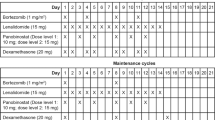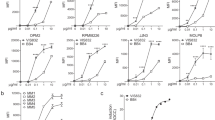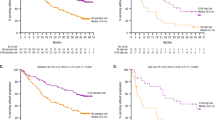Abstract
Thalidomide alone or in combination with steroids has significant activity in multiple myeloma (MM). However, given its teratogenic potential, analogs have been synthesized, retaining the anti-MM activity without these side effects. We examined the anti-MM activity of two thalidomide analogs, CPS11 and CPS49. Direct cytotoxicity of the drugs on myeloma cell lines and patient myeloma cells was examined using thymidine uptake. Tumor cell apoptosis was evaluated by flow cytometry as well as Western blotting for caspase and PARP cleavage. Cellular signaling events were examined by immunoblotting for phosphorylated proteins. Both drugs inhibit proliferation of several MM cell lines sensitive and resistant to conventional therapies. They decrease secretion of IL-6, IGF, and VEGF by marrow stromal cells. Importantly, they inhibit proliferation of MM cells adherent to stromal cells. These drugs induce caspase-mediated apoptosis in MM cell lines, as well as patient MM cells. They inhibit the PI3K/Akt and JAK/STAT (signal transducers and activators of transcription) pathways in MM cells and are antiangiogenic in matrigel-based assays. CPS11 and CPS49 have potent antimyeloma activity and can overcome protective effects of the tumor microenvironment. They have potent antiangiogenic activity and direct effect on bone marrow stroma. These encouraging preclinical data provide the basis for further evaluation in the clinic.
This is a preview of subscription content, access via your institution
Access options
Subscribe to this journal
Receive 12 print issues and online access
$259.00 per year
only $21.58 per issue
Buy this article
- Purchase on Springer Link
- Instant access to full article PDF
Prices may be subject to local taxes which are calculated during checkout






Similar content being viewed by others
References
Jemal A, Tiwari RC, Murray T, Ghafoor A, Samuels A, Ward E et al. Cancer statistics. CA Cancer J Clin 2004; 54: 8–29.
Singhal S, Mehta J, Desikan R, Ayers D, Roberson P, Eddlemon P et al. Antitumor activity of thalidomide in refractory multiple myeloma. N Engl J Med 1999; 341: 1565–1571.
Kumar S, Gertz MA, Dispenzieri A, Lacy MQ, Geyer SM, Iturria NL et al. Response rate, durability of response, and survival after thalidomide therapy for relapsed multiple myeloma. Mayo Clin Proc 2003; 78: 34–39.
Bauer KS, Dixon SC, Figg WD . Inhibition of angiogenesis by thalidomide requires metabolic activation, which is species-dependent. Biochem Pharmacol 1998; 55: 1827–1834.
Ando Y, Fuse E, Figg WD . Thalidomide metabolism by the CYP2C subfamily. Clin Cancer Res 2002; 8: 1964–1973.
Price DK, Ando Y, Kruger EA, Weiss M, Figg WD . 5′-OH-thalidomide, a metabolite of thalidomide, inhibits angiogenesis. Ther Drug Monit 2002; 24: 104–110.
Ng SS, Gutschow M, Weiss M, Hauschildt S, Teubert U, Hecker TK et al. Antiangiogenic activity of N-substituted and tetrafluorinated thalidomide analogues. Cancer Res 2003; 63: 3189–3194.
Hideshima T, Chauhan D, Shima Y, Raje N, Davies FE, Tai YT et al. Thalidomide and its analogs overcome drug resistance of human multiple myeloma cells to conventional therapy. Blood 2000; 96: 2943–2950.
Kumar S, Witzig TE, Dispenzieri A, Lacy MQ, Wellik LE, Fonseca R et al. Effect of thalidomide therapy on bone marrow angiogenesis in multiple myeloma. Leukemia 2004; 18: 624–627.
Lentzsch S, LeBlanc R, Podar K, Davies F, Lin B, Hideshima T et al. Immunomodulatory analogs of thalidomide inhibit growth of Hs Sultan cells and angiogenesis in vivo. Leukemia 2003; 17: 41–44.
LeBlanc R, Hideshima T, Catley LP, Shringarpure R, Burger R, Mitsiades N et al. Immunomodulatory drug costimulates T cells via the B7-CD28 pathway. Blood 2004; 103: 1787–1790.
Chauhan D, Li G, Shringarpure R, Podar K, Ohtake Y, Hideshima T et al. Blockade of Hsp27 overcomes Bortezomib/proteasome inhibitor PS-341 resistance in lymphoma cells. Cancer Res 2003; 63: 6174–6177.
Ng SS, MacPherson GR, Gutschow M, Eger K, Figg WD . Antitumor effects of thalidomide analogs in human prostate cancer xenografts implanted in immunodeficient mice. Clin Cancer Res 2004; 10 (Part 1): 4192–4197.
Mitsiades N, Mitsiades CS, Poulaki V, Chauhan D, Richardson PG, Hideshima T et al. Apoptotic signaling induced by immunomodulatory thalidomide analogs in human multiple myeloma cells: therapeutic implications. Blood 2002; 99: 4525–4530.
Ogata A, Chauhan D, Teoh G, Treon SP, Urashima M, Schlossman RL et al. IL-6 triggers cell growth via the Ras-dependent mitogen-activated protein kinase cascade. J Immunol 1997; 159: 2212–2221.
Hideshima T, Nakamura N, Chauhan D, Anderson KC . Biologic sequelae of interleukin-6 induced PI3-K/Akt signaling in multiple myeloma. Oncogene 2001; 20: 5991–6000.
Hideshima T, Chauhan D, Richardson P, Mitsiades C, Mitsiades N, Hayashi T et al. NF-kappa B as a therapeutic target in multiple myeloma. J Biol Chem 2002; 277: 16639–16647.
Rajkumar SV, Leong T, Roche PC, Fonseca R, Dispenzieri A, Lacy MQ et al. Prognostic value of bone marrow angiogenesis in multiple myeloma. Clin Cancer Res 2000; 6: 3111–3116.
Kumar S, Gertz MA, Dispenzieri A, Lacy MQ, Wellik LA, Fonseca R et al. Prognostic value of bone marrow angiogenesis in patients with multiple myeloma undergoing high-dose therapy. Bone Marrow Transplant 2004; 34: 235–239.
Davies FE, Raje N, Hideshima T, Lentzsch S, Young G, Tai YT et al. Thalidomide and immunomodulatory derivatives augment natural killer cell cytotoxicity in multiple myeloma. Blood 2001; 98: 210–216.
Acknowledgements
This work was supported by NIH Grant Specialized Programs of Research Excellence (SPORE) IP50 CA10070-01, PO-1 78378, and RO-1 CA 50947; the Doris Duke Distinguished Clinical Research Scientist Award (KCA); and the Cure for Myeloma Research Fund (KCA).
Author information
Authors and Affiliations
Corresponding author
Rights and permissions
About this article
Cite this article
Kumar, S., Raje, N., Hideshima, T. et al. Antimyeloma activity of two novel N-substituted and tetraflourinated thalidomide analogs. Leukemia 19, 1253–1261 (2005). https://doi.org/10.1038/sj.leu.2403776
Received:
Accepted:
Published:
Issue Date:
DOI: https://doi.org/10.1038/sj.leu.2403776



